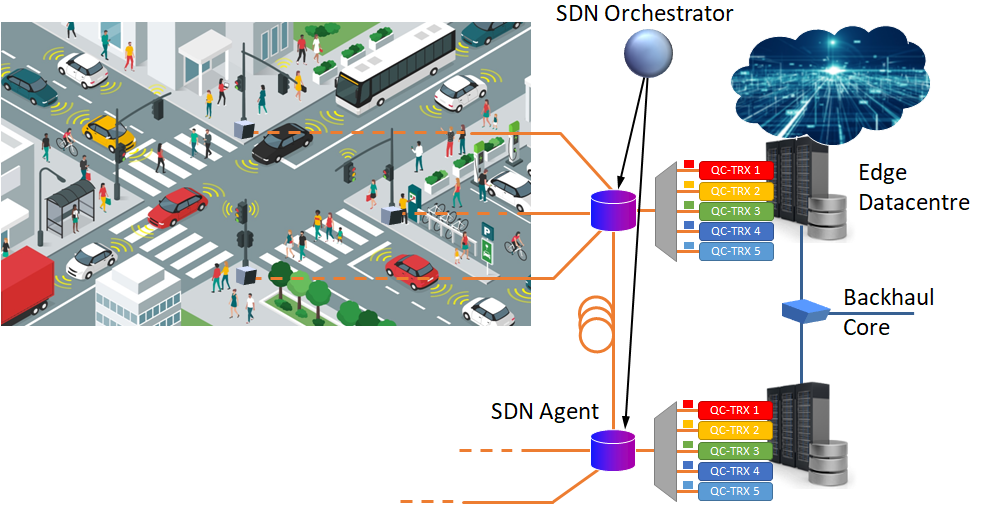AI-Enhanced Fiber-Wireless Optical 6G Network in Support for Connected Mobility

| Type | Start | End |
|---|---|---|
| European | Jan 2024 | Dec 2026 |
| Responsible | URL |
|---|---|
| José A. Lázaro (UPC), Josep R. Casas (GPI) | 6G-EWOC |
Reference
Work Programme: HORIZON-JTI-SNS-2023
Call: HORIZON-JU-SNS-2023-STREAM-B-01-03
Grant Agreement: 101139182
Acknowledgements for publications: This work has been partially supported by the 6G-EWOC project from the Smart Networks and Services Joint Undertaking (SNS JU) under the European Union’s Horizon Europe research and innovation programme under Grant Agreement No. 101139182.
Description
The sixth generation (6G) of wireless communication technology is touted as an enabler of our digital age. It bears vast potentials for individuals and businesses to enhance opportunities and create new technologies in a wide range of sectors, including industrial manufacturing, energy supply, digital healthcare, government and education, and efficient transportation.
6G-EWOC contributes to this mission through its focus on autonomous driving. By connecting vehicles and making their collected information instantaneously available to all traffic participants, 6G provides a salient feature for safety and efficient transport on the road. 6G-EWOC contributes critical technologies:
- Optical wireless comms & sensing for situational awareness & connectivity
- Seamless access to edge datacentres through a high-capacity fiber fronthaul
- Real-time processing of the collected road-side data
- Orchestration of several constituents of 6G-enabled vehicular connectivity
through artificial intelligence
Road safety is a primary concern of the modern society as accidents cut short the lives of approximately 1.2 million people every year. Moreover, road traffic injuries remain as the leading cause of death for children and young adults and are responsible for a large number of non-fatal injuries, many of them incurring disability. Automated driving, enabled through instantaneous access to information for sharpening the situational awareness, can mitigate this toll on our society while enhancing the efficiency for transporting humans and goods.
To master this challenge, a large volume of information needs to be curated and made available to all traffic participants. This necessitates an upgrade of today’s information networks, through inclusion of precise sensors, seamless connectivity at low latency, and a powerful compute infrastructures to fuse, in real time, the vast amounts of data generated along the roadside scenery.
Under the paradigm of a “connected mobility”, photonics plays a key role by virtue of its bandwidth and efficiency offerings. 6G-EWOC will develop the key components concerning high-accuracy light-based sensing, high-bandwidth wireless optical access, high-capacity fronthauling through fibre-based access, and high-end datacentre technology. While this quiver of 6G technologies is highly heterogeneous, its efficient interplay will be ensured through the involvement of artificial intelligence in the overall orchestration of the 6G network. 6G-EWOC will focus on the following scientific and technological objectives in its mission towards making connected mobility a reality.
Publications
|
Verifying Key Performance Indicators across Multiple 6G-EWOC Demonstrations. In: European Conference on Networks and Communications (EuCNC) . European Conference on Networks and Communications (EuCNC) . Poznan, Poland: IEEE; 2025. |
|
. Adaptive Fusion of LiDAR Features for 3D Object Detection in Autonomous Driving. Sensors. 2025 ;25(13). |
|
. Leveraging Quantum Machine Learning for Intrusion Detection in Software-Defined Networks. In: IEEE International Conference on Machine Learning for Communication and Networking. IEEE International Conference on Machine Learning for Communication and Networking. Barcelona: IEEE; 2025. |
|
. Quantum Machine Learning for Intrusion Detection in Software-Defined Networks. In: 1st Intl. Workshop on Quantum Computing and Artificial Intelligence (QC+AI 2025) . 1st Intl. Workshop on Quantum Computing and Artificial Intelligence (QC+AI 2025) . Philadelphia: Association for the Advancement of Artificial Intelligence (AAAI); 2025. |
|
Towards AI-Enhanced Fibre-Wireless Optical 6G Network in Support of Connected Mobility. In: IEEE 29th International Workshop on Computer Aided Modeling and Design of Communication Links and Networks (CAMAD). IEEE 29th International Workshop on Computer Aided Modeling and Design of Communication Links and Networks (CAMAD). Athens: IEEE; 2024. |
|
6G-EWOC: Optical Wireless Communication in Support of Autonomous Driving. In: IEEE Future Networks World Forum: Symposium on Future Networks for Connected and Automated Mobility . IEEE Future Networks World Forum: Symposium on Future Networks for Connected and Automated Mobility . Dubai: IEEE; 2024. |
|
6G-EWOC: Crowdsourced SLAM Data Fusion for Safe and Efficient ADAS Driving. In: IEEE Future Networks World Forum: Symposium on Future Networks for Connected and Automated Mobility . IEEE Future Networks World Forum: Symposium on Future Networks for Connected and Automated Mobility . Dubai: IEEE; 2024. |
|
. Experimental evaluation of a MIMO radar performance for ADAS application. Telecom. 2024 ;5(3):508-521. |
Collaborators
| Josep R. Casas | Associate Professor | josep.ramon.casas@upc.edu |
| Javier Ruiz Hidalgo | Associate Professor | j.ruiz@upc.edu |
| Philippe Salembier | Professor | philippe.salembier@upc.edu |

